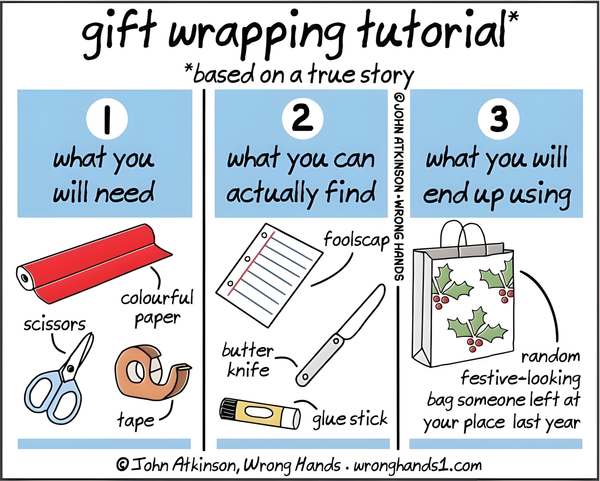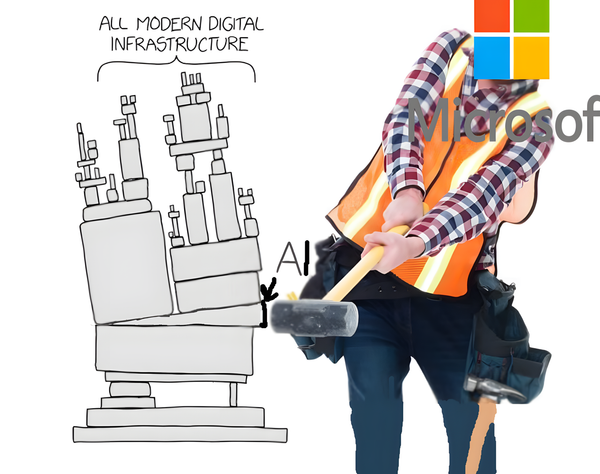The Managers' Guide #109

hacker: I am spying on you through your webcam
linux user: omg you got it working?
Eyes light up (ELU)
This is the moment when your audience is viscerally, undeniably excited about what you’re talking about. Aim for ELU.
- 🔥 Growth comes from recognizing patterns — Understanding common patterns in successful people allows you to build those traits in yourself, rather than just admiring them from afar.
- 👀 The "eyes light up" signal — When someone's eyes sparkle while discussing a topic, it reveals genuine passion and expertise. This is a powerful indicator that's nearly impossible to fake.
- 💡 Follow the energy — Pay attention to what energizes you and others. These moments of authentic enthusiasm are signposts pointing toward deeper interests and potential paths.
- 🎯 Make decisions using energy signals — When considering opportunities, prioritize those that genuinely excite you rather than those that just look good on paper or for your resume.
- 🔄 Expertise is cyclical — True expertise follows a pattern: curiosity leads to learning, which leads to sharing knowledge, which reinforces more learning.
- 🗣️ External validation comes after internal motivation — Passion typically precedes recognition; people who excel usually love what they do first, then gain acclaim later.
On Experimentation And Trust
- 🧪 Experimentation requires psychological safety — Teams need an environment where they feel safe to try new things without fear of punishment for failure, which requires establishing baseline trust.
- 🛡️ Trust comes before innovation — Leaders must build trust first through reliability, empathy, and consistent behavior before expecting teams to take risks with experimentation.
- 🔄 Trust-building is a cycle — The article describes a virtuous cycle where trust enables experimentation, which creates learning, which builds more trust when handled well.
- 📈 Four levels of experimentation maturity — Organizations progress from ad-hoc experiments to systematized innovation cultures, with increasing levels of trust required at each stage.
- 💬 Psychological safety indicators — Teams with high trust openly discuss failures, share incomplete work, and admit knowledge gaps without fear of judgment.
- 🚫 Warning signs of low trust — When teams hide failures, avoid asking questions, or work in isolation, it signals insufficient safety for meaningful experimentation.
- 👩💼 Leadership behaviors matter most — How leaders respond to failure (with curiosity vs. blame) dramatically impacts whether a team will continue taking innovative risks.
- 🏗️ Practical trust-building steps — The article recommends specific actions like creating clear agreements, modeling vulnerability, and celebrating learning from failures.
The Rotation Program That Keeps This Startup’s Engineers Learning — and Not Leaving
- 🔄 Segment's Rotation Program success — Engineering rotation programs help reduce attrition, with Segment seeing a 95% retention rate among rotation participants compared to 60-80% for non-participants.
- 🌱 Structured growth opportunity — Engineers rotate through different teams every 4 months, gaining diverse experience across infrastructure, data pipeline, and customer-facing products while building valuable institutional knowledge.
- 🧠 Learning mindset cultivated — The program addresses "innovation stagnation" by regularly exposing engineers to new challenges and technologies, preventing boredom and skill plateaus.
- 🤝 Enhanced cross-team collaboration — Engineers who've worked across multiple teams build empathy and communication bridges, reducing the "us vs. them" mentality common in engineering organizations.
- 📊 Careful measurement drives success — Segment tracks rotation impact through metrics like code quality, team velocity, and retention rates, while collecting qualitative feedback through retrospectives.
- ⚠️ Challenges acknowledged — The program requires careful timing considerations, proactive preparation by managers, and setting realistic expectations about productivity drops during transitions.
- 💼 Implementation roadmap provided — The article outlines specific steps for companies wanting to start their own rotation program, including selecting participants, timing rotations, and establishing clear program goals.
The Decision Triangle
- 🔺 The Decision Triangle framework — A mental model with three key components: the decision itself, who makes it, and how it's made, all working together as an integrated system.
- 🎯 Clear decision definitions matter — Well-defined decisions have explicit outcomes, scope, constraints, and criteria, helping avoid confusion and ensuring focus on the right problem.
- 👥 Decision-maker selection is critical — Choosing the right person/group to make a decision involves balancing expertise, authority, and stake in the outcome, not just defaulting to hierarchy.
- 🛠️ Process should match decision type — Different decisions require different approaches: consensus for alignment, consultation for complex issues, and command for urgent matters.
- ⚖️ Balance is key — The three elements must work together; a perfectly defined decision with the wrong decision-maker or process will still fail.
- 🚧 Common failure patterns identified — Problems like "decision theater" (fake decisions), "hidden deciders" (unclear authority), and "process theater" (following process without purpose) derail effective decision-making.
- 🧭 Framework serves as diagnostic tool — When decisions go wrong, examining which corner of the triangle failed helps identify specific improvements rather than completely overhauling decision processes.
We Kind of Suck at That Right Now
- 🗣️ Normalizing improvement discussions — The phrase "we kind of suck at that right now" creates psychological safety by acknowledging current limitations while implying future growth is possible and expected.
- 🛡️ Defusing defensiveness — Adding "right now" transforms criticism from a permanent judgment into a temporary state, reducing defensive reactions and opening space for improvement conversations.
- 🧠 Shifting from fixed to growth mindset — This language pattern helps teams move from seeing skills as static traits ("we're bad at this") to viewing them as capabilities that can be developed over time.
- 🔄 Creating continuous improvement culture — Using this phrase regularly establishes an environment where identifying weaknesses becomes normal and non-threatening rather than exceptional or alarming.
- 👥 Building team cohesion — The "we" framing creates shared ownership of both the problem and potential solutions, avoiding blame while fostering collective responsibility.
- 💡 Practical application suggestions — The author recommends using this phrasing in retrospectives, planning sessions, and even including "things we kind of suck at right now" as a standard agenda item.
- ⚠️ Warning against fake vulnerability — For this approach to work, acknowledgment must be genuine; pretending to be vulnerable about weaknesses while actually deflecting responsibility undermines trust.
That’s all for this week’s edition
I hope you liked it, and you’ve learned something — if you did, don’t forget to give a thumbs-up, add your thoughts as comments, and share this issue with your friends and network.
See you all next week 👋
Oh, and if someone forwarded this email to you, sign up if you found it useful 👇



